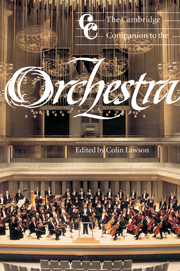Book contents
- Frontmatter
- 1 The history of the orchestra
- 2 The development of musical instruments: national trends and musical implications
- 3 The orchestral repertory
- 4 From notation to sound
- 5 The art of orchestration
- 6 The history of direction and conducting
- 7 International case studies
- 8 The revival of historical instruments
- 9 Recording the orchestra
- 10 Training the orchestral musician
- 11 The life of an orchestral musician
- 12 Historical recordings of orchestras
- 13 The orchestral composer
- 14 Educational programmes
- 15 The future of the orchestra
- Notes
- Appendices
9 - Recording the orchestra
Published online by Cambridge University Press: 28 September 2011
- Frontmatter
- 1 The history of the orchestra
- 2 The development of musical instruments: national trends and musical implications
- 3 The orchestral repertory
- 4 From notation to sound
- 5 The art of orchestration
- 6 The history of direction and conducting
- 7 International case studies
- 8 The revival of historical instruments
- 9 Recording the orchestra
- 10 Training the orchestral musician
- 11 The life of an orchestral musician
- 12 Historical recordings of orchestras
- 13 The orchestral composer
- 14 Educational programmes
- 15 The future of the orchestra
- Notes
- Appendices
Summary
‘Will the Oracle in the Cave of Harmony please speak?’ According to legend, the conductor Sir Thomas Beecham would utter these words on completing a recording take. ‘The Cave of Harmony’ was the recording booth. ‘The Oracle’ was the recording engineer.
If Beecham's sarcastic wit endeared him to his champions, it probably upset some of his collaborators. Working (literally) at the cutting edge, his engineers, like today's, would have been doing their best to capture his performances in their full glory, but for most of Beecham's lifetime they were constrained by an inadequate medium. Not only was the sound quality deficient, but the performances themselves were also compromised. The maximum time that could be recorded on one side of a 78 rpm shellac disc was about five minutes. Domestic listeners to extended classical works were obliged to change record sides at frequent intervals, which impaired concentration, and broadcasters had to resort to multiple copies and deft changeover procedures in order to present a recorded work in uninterrupted form. Moreover, conductors were obliged to choose tempi that matched side changes to natural musical junctions, so when, for example, we hear Gustav Holst conducting ‘Mars’ from his own Planets suite in a very fast five minutes, it is unwise to deduce that this reveals the definitive tempo.
- Type
- Chapter
- Information
- The Cambridge Companion to the Orchestra , pp. 169 - 179Publisher: Cambridge University PressPrint publication year: 2003



